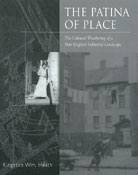The Patina of Place
The Cultural Weathering of A New England Industrial Landscape

- Author(s): Heath, Kingston Wm
- Series:
- Imprint: Univ Tennessee Press
- Publication Date: 2016-02-18
- Status: Active
- Available in Paper: Price $29.95 | Buy Now
- Leaf eReader required for PDF ebooks
Awarded the 2002 Abbott Lowell Cummings Prize
“In clear, engaging prose Kingston Heath’s book, The Patina of Place, presents a multidisciplinary analysis of workers’ housing in New Bedford, Massachusetts, breaking new ground in analyzing vernacular architecture.”—Bernard L. Herman, author of Architecture and Rural Life in Central Delaware 1700-1900
In the late nineteenth and early twentieth centuries, the booming textile industry turned many New England towns into industrialized urban centers. This rapid urbanization transformed the built environment of communities such as New Bedford, Massachusetts, as new housing styles emerged to accommodate the largely immigrant workforce. In particular, the wood-frame “three-decker” became the region’s multifamily housing design of choice and is widely acknowledged as a unique architectural form that is characteristic of New England. In The Patina of Place, Heath offers the first book-length analysis of the three-decker and its cultural significance, revealing New Bedford’s evolving regional identity within New England.
Using the concept of “cultural weathering” to explore the cultural imprints left by inhabitants on their built environment, Heath considers whether the three-decker is a generic “type” that could be transferred elsewhere. Specifically, he shows how the three-decker was lived in, and used by, its original inhabitants and illustrates its transformation by later generations of residents following the collapse of the textile industry in the mid-1920s.
The Patina of Place focuses on the three-decker in New Bedford, but its overarching theme concerns the cultural, economic, and social complexities of place-making and the creation of regional identity. Heath offers a broad investigation of the forces that drive the production and consumption of architecture, at the same time providing an economic and cultural context for the emergence of a particular architectural form.
Kingston Wm. Heath is a professor in the Historic Preservation Program at the University of Oregon. His articles have appeared in The Encyclopedia of Architecture and Old-Time New England, among other publications.
